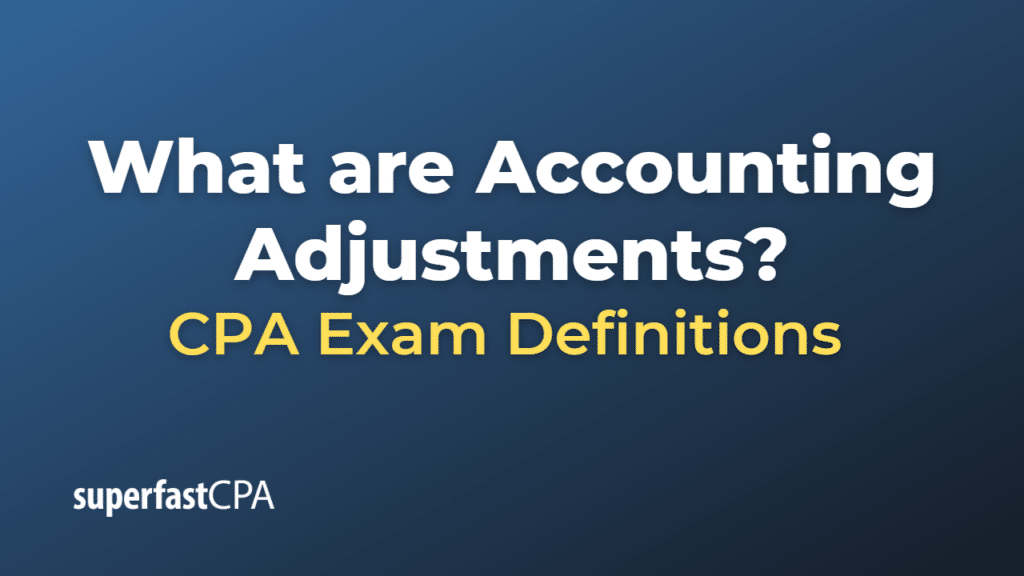Accounting Adjustments
Accounting adjustments are entries made in the general ledger at the end of an accounting period to accurately reflect the revenues and expenses for that period. These adjustments ensure that financial statements are prepared in accordance with the accrual basis of accounting, which requires revenues to be recognized when they are earned and expenses to be recognized when they are incurred, regardless of when cash is received or paid.
There are several types of accounting adjustments:
- Accruals: These adjustments record revenues or expenses that have been earned or incurred during the accounting period but have not yet been recorded in the general ledger. For example, if a company provides services to a client in December but has not yet billed the client, an adjusting entry is made to recognize the revenue earned in December.
- Deferrals: These adjustments involve revenues or expenses that have been received or paid in advance but have not yet been earned or incurred. For example, if a company receives a rent payment for the next three months in advance, the rent is initially recorded as a liability called “unearned revenue.” An adjusting entry is made at the end of each month to recognize the portion of the rent that has been earned.
- Depreciation: This adjustment allocates the cost of a tangible asset, such as equipment or a building, over its useful life. Depreciation expense is recorded at the end of each accounting period to reflect the portion of the asset’s cost that has been used up during that period.
- Bad debts: This adjustment estimates and records the portion of accounts receivable that is expected to be uncollectible. Companies may use various methods to estimate bad debts, such as the percentage of sales method or the aging of accounts receivable method.
- Inventory adjustments: These adjustments are made to update the inventory balance for any changes that have occurred during the accounting period, such as write-downs for obsolete or damaged inventory, or adjustments for physical inventory counts that differ from the recorded inventory balance.
- Prepaid expenses: These adjustments involve expenses that have been paid in advance but have not yet been used up or consumed during the accounting period. For example, if a company pays for a one-year insurance policy in advance, the prepaid insurance is initially recorded as an asset. An adjusting entry is made at the end of each month to recognize the portion of the insurance expense that has been incurred.
By making these accounting adjustments, companies can ensure that their financial statements accurately reflect their financial performance and position for the accounting period, providing a more accurate picture of the company’s financial health to stakeholders such as investors, creditors, and management.
Example of Accounting Adjustments
Let’s consider a fictional example of a small graphic design company called “Creative Design Studio” to illustrate how accounting adjustments are used at the end of the accounting period.
On December 31, the company’s accountant is preparing the financial statements for the year. They identify several transactions that require accounting adjustments:
- Accruals: Creative Design Studio completed a project for a client in December, but the client has not been billed yet. The project’s revenue of $5,000 needs to be recognized in December. The accountant makes an adjusting entry, debiting accounts receivable for $5,000 and crediting service revenue for $5,000.
- Deferrals: The company received $6,000 in advance from a client for a six-month project starting in December. The accountant records an adjusting entry to recognize the $1,000 of revenue earned in December, debiting unearned revenue for $1,000 and crediting service revenue for $1,000.
- Depreciation: Creative Design Studio has office equipment with a cost of $12,000 and a useful life of 4 years. The accountant records an adjusting entry for depreciation expense, debiting depreciation expense for $3,000 ($12,000 ÷ 4 years) and crediting accumulated depreciation for $3,000.
- Bad debts: The company estimates that 1% of its accounts receivable balance of $50,000 will be uncollectible. The accountant records an adjusting entry, debiting bad debt expense for $500 ($50,000 × 1%) and crediting allowance for doubtful accounts for $500.
- Prepaid expenses: Creative Design Studio paid $2,400 for a one-year insurance policy in advance. The accountant records an adjusting entry to recognize the insurance expense for December, debiting insurance expense for $200 ($2,400 ÷ 12 months) and crediting prepaid insurance for $200.
By making these accounting adjustments, the accountant ensures that Creative Design Studio’s financial statements accurately reflect its financial performance and position for the year. These adjustments help provide a more accurate picture of the company’s financial health to stakeholders such as investors, creditors, and management.













